The Ultimate Car Seat Guide
Your ultimate car seat explainer: learn the different types of seats, what you’ll need when and browse our top picks.
By Jen LaBracio, CPST | Fact Checked by Rebekah Kimminau
Babylist editors love baby gear and independently curate their favorite products to share with you. If you buy something through links on our site, Babylist may earn a commission.

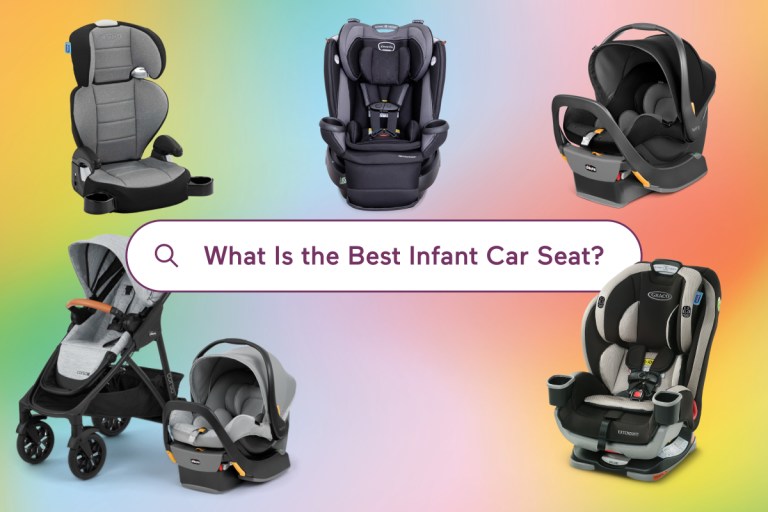
Whether you’re a first-time parent-to-be researching the best infant car seat to add to your baby registry or a seasoned mom shopping for the safest booster seat for your second grader, the world of car seats can feel overwhelming—and for good reason. There are a lot of technical terms to learn and digest. Knowing which seat to use when is confusing. And wading through the many car seats on the market to figure out which one is right for you can feel pretty daunting.
“Car seats are often one of the most intimidating items to research,” says Rebekah Kimminau, a Child Passenger Safety technician (CPST) and founder of The Baby Gear Consultant. “Even once you are a parent and have experience using car seats, they can continue to feel overwhelming to purchase and install,” she says.
What you’ll quickly realize is that car seats are going to be a part of your life for at least the next decade—so learning the ins and outs is important. “If you spend time researching anything, it should be car seat safety,” says Kimminau. Bookmark this guide as the first stop every time you need to choose a car seat. We’re walking you through everything you need to know: the different types of seats, from infant car seats all the way through boosters; how to know which seat to use when and when to make the switch; and our picks for the best car seat in each category.
As Babylist’s gear editor, I’ve personally tested and reviewed dozens of car seats. I’ve interviewed countless car seat experts, including Child Passenger Safety technicians (CPSTs), pediatricians and other safety experts, and sifted through data and feedback from thousands of parents through Babylist’s annual Best Baby Products survey of over 6,000 Babylist users. I also have over a decade of hands-on car seat experience—from infant car seats through booster seats—as a mom of two boys, ages 10 and two. I drew from these experiences to compile this best of list. I also researched and consulted the latest safety recommendations from both the National Highway Traffic Safety Administration (NHTSA) and the American Academy of Pediatrics (AAP).
In This Article
- Infant Car Seats
- Car Seat Stroller Combo
- Convertible Car Seats
- Rotating Car Seats
- All-in-One Car Seats
- Travel Car Seats
- Booster Seats
- How We Chose the Best Car Seats
- How to Choose a Car Seat
Best Infant Car Seat
What it is
An infant car seat is a car seat made specifically for younger babies.
Extended rear-facing refers to keeping your child rear-facing in their car seat until they max out the seat’s rear-facing limits.
When you need one
Infant car seats can be used from birth until your baby reaches the seat’s height or weight maximum. For most seats, these top limits are around 30-35 inches for height or 30-35 pounds for weight—whichever your child hits first.
What else you need to know
- Infant car seats always face the rear of a vehicle.
- Almost all infant car seats attach to a base. The base stays installed in your vehicle and the seat clicks in and out of the base.
- Most infant car seats can also be used without a base; in that case, you’ll use your vehicle’s seat belt or built-in connectors called LATCH to install the seat and keep it secure.
- All car seats sold in the US must pass the same federal safety standards set by the NHTSA, a division of the United States Department of Transportation.
- It’s possible to skip an infant car seat and go directly to a convertible car seat; however, you’ll lose the ability to transfer your baby in and out of your car or stroller while still in their car seat, as convertible seats are large, heavy and designed to remain installed in a vehicle. You’ll also need to purchase a convertible car seat for each vehicle you own instead of simply purchasing an additional car seat base for your infant seat.
Best Infant Car Seat
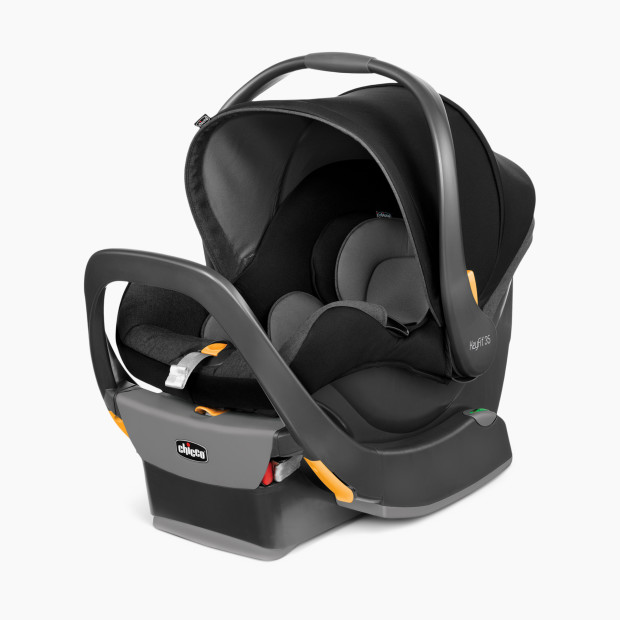
Chicco KeyFit 35 Infant Car Seat - Onyx
Babylist $229.99
Amazon $229.99
Walmart $229.99
Target $229.99
From ease of install and excellent safety features to its slim profile and extended rear-facing limits, I can’t say enough good things about the Chicco KeyFit 35. And it’s not just my top pick; it’s also a parent and car seat safety expert favorite. (The parents we spoke to highlighted how easy it was to install and that it was lighter than many other infant car seats they’ve tried. Kimminau raves about the “tried and true installation that’s one of the easiest on the market” and the extra safety features.) It’s a well-priced seat that includes both safety extras like an anti-rebound bar (to prevent extra movement in the event of a crash) and convenience features like a no-rethread harness (so you can adjust the straps without having to undo and reroute them) and a removable, washable seat cover.
Did you know you can buy infant car seats from the Babylist Shop? And for more information on infant car seats including infant car seat terminology, understanding safety features, how to choose the best infant car seat for you and our full list of top picks, visit the Best Infant Car Seats guide.
Best Car Seat Stroller Combo
What it is
A car seat stroller combo, also called a travel system, is an infant car seat and a stroller that attach.
A travel system lets you stroll with your newborn before they can sit up on their own—and makes car-seat-to-stroller transfers (and back again) a lot easier.
When you need one
A travel system is designed to be used from birth. That’s because unless your stroller comes with a bassinet attachment or fully reclines and is approved for newborn use, it’s not suitable for your little one until they can sit up on their own—which usually happens around six months of age. Most infant car seats included in travel systems can be used for about a year (until your baby hits either the height or weight maximum), and most strollers can be used well through the toddler years.
What else you need to know
- A travel system solves for strolling with your newborn before they’re able to sit up on their own. It also means you don’t have to disturb your little one every time you need to make the switch between your car seat and your stroller.
- Travel systems can be purchased in two ways: as a package deal from the same brand or as a “make your own” set that combines a stroller and a car seat from different brands using adapters.
- Package deals are usually more economical and (usually) don’t require adapters. DIY car seat stroller combos from different brands allow you to mix and match but require adapters to work together.
- The American Academy of Pediatrics (AAP) recommends against using car seats for sleep outside of a car. If your baby falls asleep in their car seat, remove them and place them in a safe sleep space like a crib, bassinet or playard as soon as possible.
Best Car Seat Stroller Combo
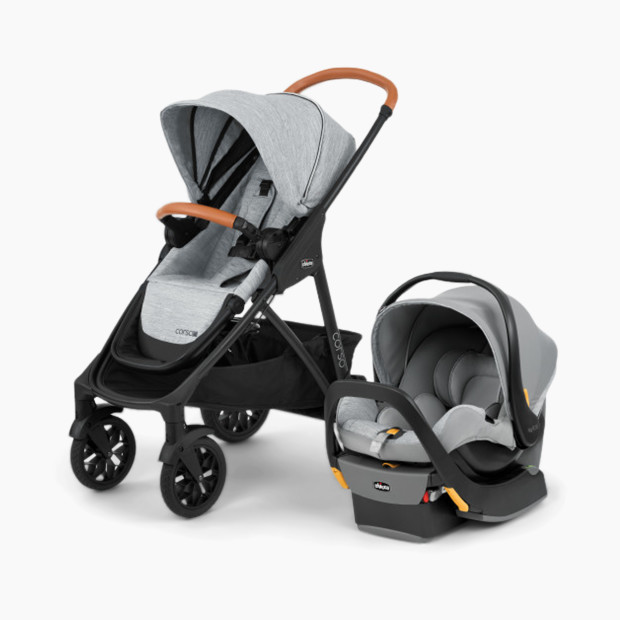
Chicco Corso LE Modular Travel System - Veranda
Babylist $599.99
Amazon $599.99
Walmart $599.99
Target $599.99
Most car seat stroller combos offer value, but not all offer quality. This one from Chicco delivers on all fronts and is an excellent combination of price, features and performance. Also called a travel system, this car seat and stroller combo includes my top infant car seat pick (and popular parent favorite), Chicco’s KeyFit 35, alongside a stroller with many high-end features including foam-filled tires, a suspension system, a huge storage basket and a multi-position reclining seat. And while it’s not inexpensive, this travel system offers incredible value for the quality.
You can buy a travel system from the Babylist Shop and learn more about how to choose a car seat stroller combo, what features to prioritize and find other top picks in the Best Travel Systems guide.
Best Convertible Car Seat
What it is
A convertible car seat is a car seat that can be used with children of various sizes and can change from a rear- to a forward-facing seat. Convertible car seats don’t have bases like infant seats; instead, they use your vehicle’s seat belt or LATCH system for installation.
Convertible car seats are designed to stay installed in your car, unlike infant car seats which are a lot more portable.
When you need one
You can use a convertible car seat from birth until the preschool years and beyond. Car seat safety experts recommend children remain in a convertible car seat until they outgrow the seat by either the height or weight restrictions, which vary depending on the particular seat.
What else you need to know
- A convertible car seat starts in the rear-facing position for babies and toddlers then can be turned forward-facing as your child gets older based on the height and weight limits of your particular seat. Some even turn into booster seats for school-aged children.
- Convertible car seats are heavy and bulky. They’re designed to be installed in your vehicle and stay there, unlike infant car seats which are much more portable.
- When to switch to a convertible car seat is one of the most common car seat questions parents have. You should keep your child rear-facing in their convertible car seat until they reach the top height or weight limit allowed by your seat’s manufacturer. “More and more research shows that rear-facing children until they are three, four, five or beyond helps prevent injuries in a crash,” explains Kimminua. “Rear-facing distributes the forces of a crash more evenly over the body and spine and cradles/protects a child’s head, instead of letting it move forward as it does when a child is forward-facing.” The AAP, National Highway Traffic Safety Administration and many other experts also all agree on the benefits of extended rear-facing.
Best Convertible Car Seat
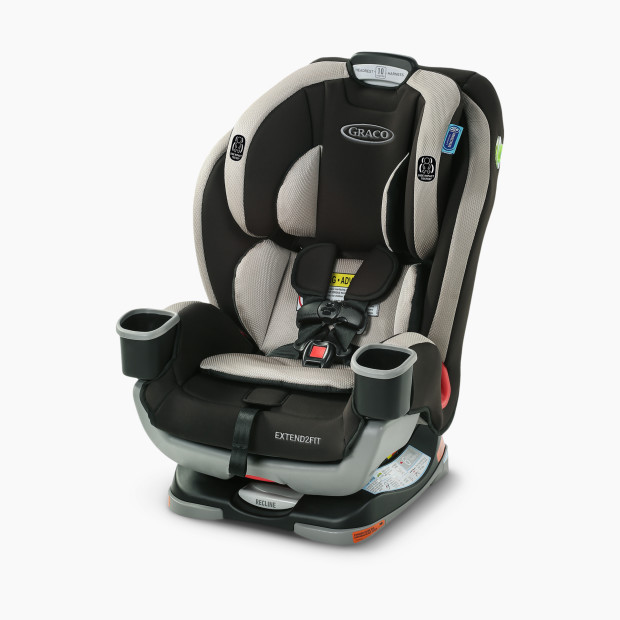
Graco Extend2Fit 3-in-1 Car Seat - Stocklyn
Babylist $249.99
Amazon $249.00
Target $249.99
“The original Graco Extend2Fit is one of the most-loved budget-friendly seats. This 3-in-1 version takes all of the beloved features of the original and adds on even more,” shares Kimminau. Personally, I’m partial to any car seat that allows for extended rear-facing (the safest way for your little one to ride)—and this seat from Graco is designed with this safety feature specifically in mind. (Many parents also choose this seat for exactly this reason.) It fits well in almost any type of car, even smaller vehicles, and is affordable and easy to install. It also converts to a high-back booster for years of use.
You can buy convertible car seats from the Babylist Shop or head to our Best Convertible Car Seats guide for more best-of picks plus information on extended rear-facing, features to look for in a convertible seat and convertible car seat FAQs. Let Us Help You Pick Your Next Car Seat is another good resource to consult when it’s time to make the switch.
Best Rotating Car Seat
What it is
A rotating car seat is a type of convertible car seat that spins on its base either 180 or 360 degrees.
When you need one
Like convertible car seats, rotating car seats can be used from birth until your child reaches the maximum height or weight limits allowed by your particular seat. Most rotating seats will last you into the preschool years, and some even longer.
What else you need to know
- Rotating car seats make it easier to get your little one in and out of the car, especially when they’re rear-facing. Many parents choose a rotating seat for this ease-of-use feature.
- Rotating seats also make it easier to rear-face your child—and when something is easier, you’re more likely to do it. They can also help with safety. “The rotating features helps caregivers better view their child when they are putting them in the seat, and this helps to ensure the child is properly harnessed every time,” explains Kimminau.
- Rotating car seats can make it easier for parents and caregivers with certain physical disabilities to load a child in and out of a car seat.
- Rotating car seats are safe, but you need to be sure you’re using them properly. When using a rotating car seat, always be sure the seat is in the locked position (either forward- or rear-facing) when driving. Never let your child ride in a rotating car seat when it’s unlocked and never drive with the seat in an unlocked position, even if your child isn’t riding in the seat.
Best Rotating Car Seat
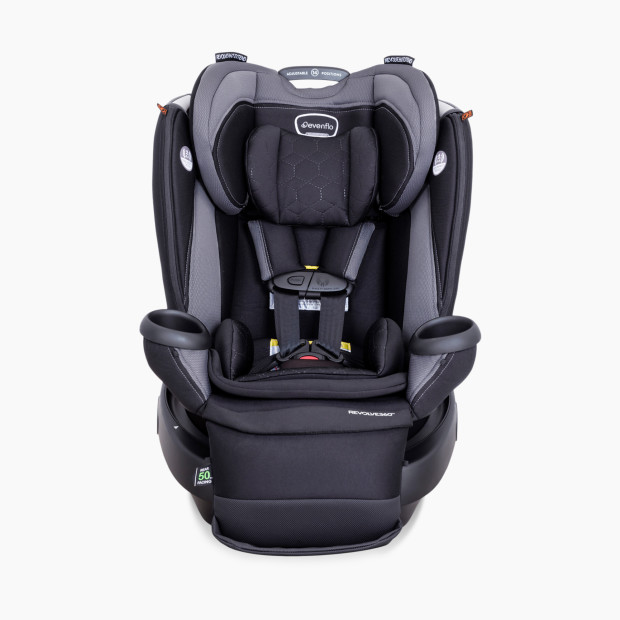
Evenflo Revolve360 Extend All-in-One Rotational Convertible Car Seat - Revere
Babylist $399.99
Amazon $399.99
Walmart $399.99
Target $399.99
This rotating car seat is easy to install, packed with safety features and can be used for 10 years. Kimminau praises the “high rear-facing limit of 50 pounds” and the “smooth rotating feature and no-rethread harness for easy adjusting as your child grows.” It scores major points in my book for price (below many other rotating car seats on the market) and the fact that you only need to install it once if you use the seatbelt installation method.
If you think a rotating car seat might be right for you, you can learn more about these innovative seats and see our full list of top picks in the Best Rotating Car Seats guide or buy a rotating car seat from the Babylist Shop.
Best All-in-One Car Seat
What it is
An all-in-one car seat is a convertible car seat that’s designed to work from infancy through the elementary school years. All-in-one seats transform from rear-facing seats to forward-facing ones and then ultimately to booster seats.
When you need one
You can use an all-in-one car seat from birth until your child reaches the top height or weight limits allowed by your particular seat. Most all-in-one car seats will last into the elementary school years.
What else you need to know
- Many all-in-one car seats have a lifespan of about a decade. This means that instead of purchasing three or even four different seats as your child grows, you’ll need only one.
- Some all-in-one car seats convert to both a high-back booster (a seat with a bottom and a back) and a backless booster (a seat with just a bottom), while other models end up only as high-back booster seats.
Best All-in-One Car Seat
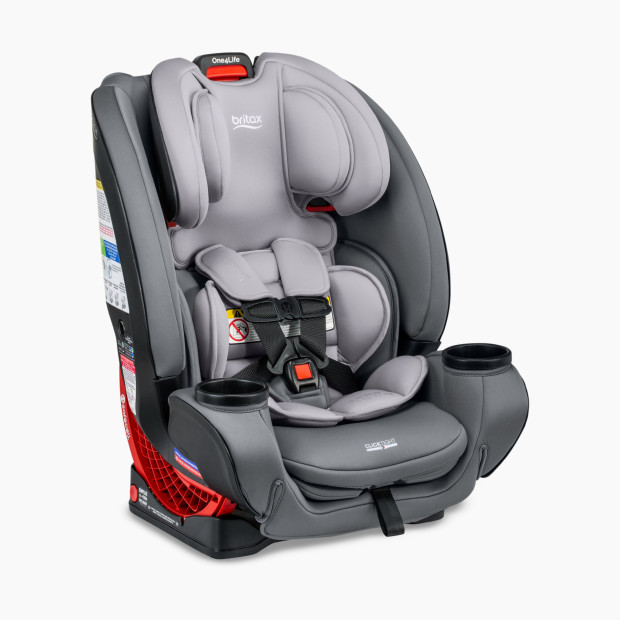
Britax One4Life ClickTight All-in-One Car Seat - Glacier Graphite
Babylist $349.99
Amazon $279.97
Target $349.99
My top convertible car seat pick, the Graco Extend2Fit 3-in-1 Car Seat, does function as an all-in-one seat, as it ultimately converts to a high-back booster. But for another top contender, check out the Britax One4Life. It’s one of the easiest car seats to install (a properly installed car seat = a safe car seat) thanks to Britax’s patented ClickTight technology. “Britax ClickTight car seats have been around for 10+ years and are known as some of the easiest-to-install on the market,” says Kimminau. It converts from a rear-facing infant seat to a forward-facing five-point harness seat and then eventually to a high-back belt-positioning booster.
Babylist’s Best All-in-One Car Seats guide walks you through everything you need to know about all-in-one seats plus our other best-of recommendations. You can also buy an all-in-one car seat from the Babylist Shop.
Best Travel Car Seat
What it is
There’s no true definition or specific categorization of a “travel” car seat; instead, what defines a travel-friendly car seat is its features. Things like a lighter weight, compact design and ease of portability are all factors to consider when you’re shopping for this type of seat.
When you need one
Most parents will use their everyday infant car seat if they’re traveling with a younger baby. But once your little one outgrows their infant seat, you may want a travel-specific convertible car seat since many other convertibles are large and heavy. Most travel car seats have the same or slightly lower height and weight maximums as regular car seats and can be used with babies, toddlers and preschool-aged kids.
What else you need to know
- Determining if you need a travel car seat will depend on your family’s lifestyle. “If you travel frequently by airline, you may want to consider investing in a travel-friendly convertible car seat,” explains Kimminau. “Most people will find the need to bring a car seat with them when travelling, since renting one at your destination is not advisable. Many standard convertible car seats are heavy and cumbersome to bring along with you, so people will invest in lighter, simpler seat.”
- Weight and ease of installation are the two biggest features to look for in a travel car seat. You’ll also want to be sure your seat is FAA-approved if you’re planning to take it on an airplane.
- A travel-friendly car seat isn’t only for travel. Compact, lightweight seats can be a great choice if you’re an urban family that doesn’t own a car or if you need a seat for a grandparent or other caregiver.
Best Car Seat for Travel
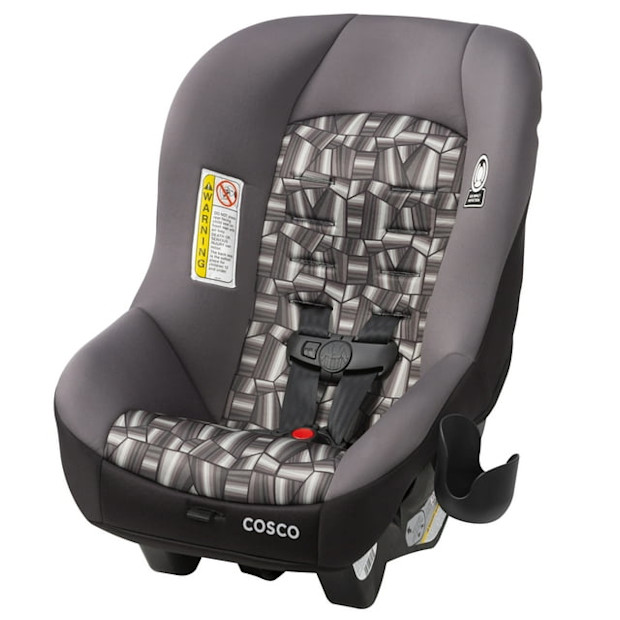
Cosco Scenera NEXT Convertible Car Seat
Walmart $59.98
“One of the lightest convertible car seats on the market” according to Kimminau, the Cosco Scenera has been my go-to travel car seat for over a decade. Weighing in at only 10 pounds, this convertible car seat is as travel-ready as it gets. It’s easy to sling over your shoulder while you’re walking through the airport or install in an airplane seat or a ride share. It’s no-frills and takes a little practice to get a secure install, but it’s slim, safe and extremely affordable. Just note that it does have lower weight and height limits, so it won’t last your child as long as most convertible car seats, explains Kimminau.
Before you head off on your next trip, consult our Best Car Seats for Travel guide for our other top travel-friendly car seat picks and more tips on how to choose a travel car seat.
Best Booster Seats
What it is
A booster seat uses a vehicle’s seat belt as a restraint. Think of a booster as the step between a car seat and a seat belt; it elevates a child in a car’s seat, making adult seat belts fit better on little bodies.
Most kids aren’t mature enough for a booster until at least five years old.
When you need one
It’s time to move to a booster seat once your child maxes out the top limits of their forward-facing convertible car seat. “Lately it seems popular to encourage your child to move to the next stage quickly—but for car seats, it can be a grave mistake,” explains Kimminau. Before transitioning from a harnessed seat to a booster, there are some critical milestones your child should meet. “Most importantly, they need the maturity to sit correctly in their booster seat every car ride, for the entire duration of the ride. If, at any point, they are slouching or not sitting correctly, the seat belt will restrain them properly in the event of a crash.” You’ll also want to make sure your child meets the minimum height and weight requirements of the booster seat and has a proper seat belt fit. (Most kids aren’t mature enough to sit properly in a booster until at least five years old; most hit this milestone sometime between five and seven.)
What else you need to know
- There are two types of booster seats: high-back and backless boosters.
- A high-back booster is similar to a car seat in that it is a mini-sized seat, with a bottom and back, placed on a passenger seat. High-back boosters have a seat belt guide through which you can thread a vehicle’s shoulder belt for a proper fit.
- Backless boosters have only a seat component to provide the extra height needed to position your child properly in a vehicle’s seat. Backless boosters have seat belt guides that position the belt over the correct place on the child’s body.
- Booster seats sit in the back passenger seat of a vehicle. Some rest directly on a vehicle’s seat while others use connectors and attach to your car’s lower anchors to keep the seat secured.
- Most car seat experts recommend a high-back booster for as long as possible. That’s because these types of seats do a better job of correctly positioning your child’s body and your vehicle’s seat belt, especially on smaller children.
- The AAP recommends that children remain in a booster seat until the adult seat belt fits properly—usually around when a child reaches four feet nine inches and is between eight and 12 years old.
Best Booster Seat
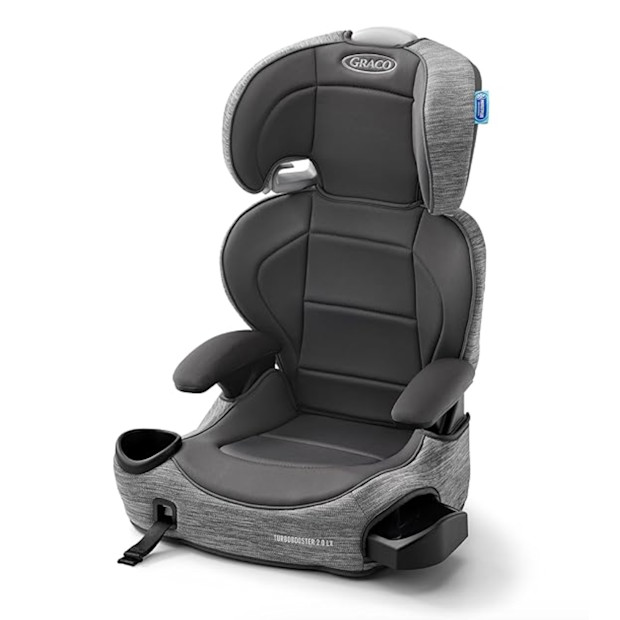
Graco TurboBooster 2.0 LX Highback Booster Seat
Amazon $89.99
Budget-friendly, light and easy to install, this high-back booster fits a wide variety of children well and transitions to a backless booster for years of use. It also has LATCH straps to secure it to the seat, which “keeps your seat from sliding around the back seat when unoccupied or between uses,” says Kimminau. It’s the booster I come back to again and again even after trying more elaborate, more expensive models. The seat also has cupholders and height-adjustable armrests.
Buy booster seats from the Babylist Shop or learn more about how to know when it’s time to transition your child to a booster seat and what other picks topped our list in the Best Booster Seats guide.
How We Chose the Best Car Seats
- We analyzed results from Babylist’s Best Baby Products survey, which polled 6,000 Babylist users and asked them to share the baby products they love the most and why.
- We utilized insight from the Babylist editorial team, including Gear Editor Jen LaBracio, an expert in the baby space for over six years and a mom of two who has written hundreds of baby gear guides and personally researched and tested hundreds of baby products, including many car seats.
- We spoke to Rebekah Kimminau, CPST and founder of The Baby Gear Consultant.
- We researched information on car seats and car seat safety from leading experts including the AAP and the NHTSA.
- We reviewed customer reviews from hundreds of real Babylist parents.
How to Choose a Car Seat
A car seat is a registry must-have if you’re looking to take anything from a road trip to a ride to the grocery store with your little one in tow. But choosing one is a big decision. Here’s what you need to know.
Choose the proper type of car seat for your child
There are three main types of car seats: infant car seats; convertible car seats (including rotating and all-in-one seats); and booster seats. Your child’s age, weight and height all factor in when determining which car seat you should choose.

Should I get an infant car seat or a convertible car seat?
While many convertible car seats will work for your little one from birth, most parents decide to start with an infant car seat first. (Eighty percent of Babylist parents register for an infant seat.) But why?
- Babies under six months can’t sit up on their own, and not all strollers have the ability to fully recline the seat. If you want to stroll with a newborn, you often have to clip in an infant car seat.
- The ability to pop your infant seat out of your car and either carry it or clip it directly into your stroller means you’ll never have to wake your sleeping baby.
- Although infant car seats do click into bases, you can also install them using just a seat belt, making them easier to use in friends’ cars, cabs and ride shares.
- You can store your infant seat indoors during really hot or cold weather so it’s always at a comfortable temperature and never exposed to the elements in your car.
Some parents choose to skip an infant car seat and use a convertible from day one. It’s usually because they’re planning on babywearing often, want to save money by skipping the infant seat or are looking to limit the number of baby products they purchase.
Learn about car seat safety
The safest car seat is the one that fits your child correctly (is the right size for your child’s age, weight and height), fits your vehicle and can be installed correctly by you every time.
You’ll also want to pay attention to some specific safety features when shopping for a car seat.
- A five-point harness. This type of harness consists of two shoulder straps, two waist straps and a crotch strap that all meet in a middle buckle. Five-point harnesses are safer than three-point harnesses because they spread the force from a crash over more areas of the body. They also hold your baby in place, preventing them from wiggling into an unsafe position. A harness can’t do its job unless it’s properly fitted, so be sure it’s easy to adjust. Look for a no-rethread harness if possible; that means you’ll be able to move the seat’s shoulder straps up and down without having to manually reroute them through the back of the car seat.
- Higher rear-facing weight limit. Riding rear-facing is safer for your little one than forward-facing. Choose a seat with a high rear-facing weight limit for extended use.
- Side-impact protection. In about one-quarter of crashes, your car is hit from the side rather than the front. In 2022, the National Highway Safety Traffic Administration (NHTSA) issued a ruling mandating more comprehensive side-impact testing and performance requirements for child restraint systems, giving car seat manufacturers three years to comply with these new regulations.
- LATCH system. LATCH stands for Lower Anchors and Tethers for Children. It’s a system of built-in straps and hooks on a car seat and anchor hardware in your vehicle designed to make car seat installation safer and simpler. It has been a required standard in vehicles since 2002 and can make installing some car seats much easier. Just keep in mind that you can only use it up to a certain weight limit (check your instruction manual for the specifics for your seat) and in certain locations in a vehicle.
- Anti-rebound bar and load leg. Anti-rebound bars and load legs are two safety features you’ll see in some car seats. An anti-rebound bar reduces the movement of a car seat in a crash, halting the seat’s rebound so it can come to a stop sooner. A load leg (also called a stability leg) helps to reduce the amount of force on a car seat and also reduces the rebound of a seat in the event of a crash. A good rule of thumb to remember is that the less a car seat moves during a crash, the better—so these are safety features that some parents prioritize when shopping for a car seat.
We don’t recommend buying a previously used car seat. Used car seats may be damaged and may not meet current safety regulations. If you do decide to buy used, buy from someone you trust so you know the seat’s history. Look up the seat’s expiration date and research if that particular car seat model has ever been recalled. And be sure to follow the manufacturer’s rules around how to clean it safely.
And car seat features, too
There isn’t one magic thing that makes one car seat easier to use than another; however, there are certain features to look for when choosing a car seat that can make aspects of both installation and use of your seat a little bit easier.
- Ease of installation. Infant car seats can be installed with or without a base and can use either your vehicle’s seat belt or LATCH system, so answering, “What is the easiest way to install a car seat?” depends on what method you’ll be using to install it regularly. If you’re using LATCH, you can research your seat’s Ease of Use rating from NHTSA. Some features to look for in any brand include an easy-to-reach LATCH tightener and an easy-to-read level indicator (such as a bubble level) so you can check if your seat is level. If you’re going to be using your seat mainly in cabs, ride-shares or friends’ cars, look for a European belt path—a routing system that routes your car’s lap belt over your baby’s lap area and around the back of the infant car seat. Also look for a built-in lock-off device that clamps the seat belt in place so it can’t loosen.
- Ease of adjustment and use. Part of car seat safety is making sure the harness fits your baby’s body just right for every ride. Although all safety seat harnesses adjust, be sure the adjustments are easy to reach and simple to use. (Lots of parents prefer no-rethread harnesses over manual options.) In terms of the harness button and buckles, you want something that’s too stiff for a baby or toddler to undo by themselves but not so stiff that you’re struggling every time you need to get your little one in and out of the seat. If the button is a little uncomfortable on your thumbs, but overall doable, it’s probably about right.
- Ease of cleaning. Car seats get messy. Seats made with smooth and/or water-resistant fabrics will wipe clean more easily than seats with textured or absorbent fabric. For big messes, it’s nice to have a removable, machine-washable cover. The most important thing to remember is that each car seat has its own very specific cleaning guidelines; always consult the instruction manual to learn how to clean a car seat.
Consider car seat placement and fit
Not all car seats fit in all cars. Some bases are too large for certain vehicle seats, and some car seats are too long front-to-back to fit properly in certain vehicles. Here are a few things to consider.
- While it’s often tough to “try out” a car seat in your vehicle, especially in today’s retail environment, we recommend doing so if at all possible before you commit to a specific seat.
- Measure, measure, measure. Research a car seat’s base and front-to-back measurements and compare them to your vehicle. This is especially important if you own a smaller car or if you (or anyone else who will be driving with your child) are particularly tall.
- Besides making sure the seat physically fits in your back seat, the angle of your seat and the placement of your seat belts can also affect whether a car seat will be a good fit for your car. In most cars, the middle of the back seat is the safest spot; however, if you’re dealing with two car seats at the same time, there might not be room in the middle. Some cars also only have LATCH on the outside seats, so you’ll have to choose between a LATCH install or a middle seat.
Always consult your vehicle’s owner’s manual for any special instructions. And don’t hesitate to find a Child Passenger Safety technician (a CPST, a trained car seat expert) to check your work.
Once you choose a seat, install it properly
A safe car seat is one that’s installed properly every time. Keep these installation tips in mind.
- Make sure your car seat is installed tightly. The seat should be unable to move more than one inch side-to-side or front-to-back at its base.
- Use the correct harness slots. Harness straps should be positioned at or below your baby’s shoulders for a rear-facing seat and at or above your child’s shoulders for a forward-facing seat. They should also pass the pinch test: if the harness is snug enough, your fingers will slide off, but if it’s too loose, you’ll be able to pinch the webbing between your fingers.
- Find the correct recline. The car seat should be reclined to a safe angle so your baby’s head doesn’t fall forward. (Car seats have guidelines and adjustments to make sure you get the right incline depending on weight, height and age.)
- Car seats + winter coats don’t mix. Never strap your baby or toddler into their car seat while they’re wearing a winter coat or other heavy layers. You won’t be able to get the harness straps tight enough and your little one won’t be safe in the event of a crash. Instead, dress your little one in a few light layers or use a blanket over the car seat straps.
Jen LaBracio,
Senior Gear Editor, CPST
Jen LaBracio is Babylist’s Senior Gear Editor and a Child Passenger Safety Technician (CPST). When she’s not geeking out over car seats, testing out a new high chair or pushing the latest stroller model around her neighborhood, she likes to run, do all things Peloton, listen to podcasts, read and spend time at the beach. In her past life, she worked for over a decade in children’s publishing. She lives outside of Chicago with her husband and their two boys, Will and Ben.
This information is provided for educational and entertainment purposes only. We do not accept any responsibility for any liability, loss or risk, personal or otherwise, incurred as a consequence, directly or indirectly, from any information or advice contained here. Babylist may earn compensation from affiliate links in this content. Learn more about how we write Babylist content and review products, as well as the Babylist Health Advisory Board.











